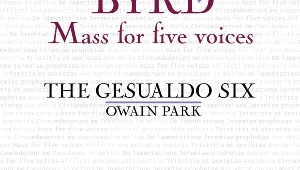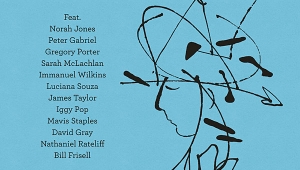| Columns Retired Columns & Blogs |
Recording of February 2003: Beethoven: Complete Violin Sonatas
BEETHOVEN: Complete Violin Sonatas
Augustin Dumay, violin; Maria João Pires, piano
Deutsche Grammophon 471 495-2 (CD). 2002. Helmut Burk, prod.; Wolf-Dieter Karwatky, eng. DDD. TT: 3:54:01
Performance *****
Sonics ****
Augustin Dumay, violin; Maria João Pires, piano
Deutsche Grammophon 471 495-2 (CD). 2002. Helmut Burk, prod.; Wolf-Dieter Karwatky, eng. DDD. TT: 3:54:01
Performance *****
Sonics ****
For the past half century, Deutsche Grammophon has released roughly one cycle of Beethoven's violin sonatas per decade, from Wolfgang Schneiderhan's mono edition and Yehudi Menuhin's stereo remakes (both with pianist Wilhelm Kempff) to the partnership of Gidon Kremer and Martha Argerich to, most recently, Anne-Sophie Mutter's cycle with Lambert Orkis, on CD and DVD. While each of these cycles boasts unquestionable virtues, all are markedly surpassed by the extraordinary standard set by violinist Augustin Dumay and pianist Maria João Pires in this new set.
 In an interview printed in the CD booklet, the artists talk of how their interpretations are the net result of more than five years of intensive preparation and rehearsal. It shows. Each performance reveals levels of ensemble refinement, attention to detail, dramatic momentum, and emotional intensity that make many other recordings of these works sound generalized in comparison. Take, for example, the frightening degree to which Dumay and Pires match their rapid passagework in the first movements of Op.12 No.3 and Op.24, or their flawlessly matched trills in the "Kreutzer" and Op.96 sonatas. If they launch into Op.30 No.3 like the proverbial bats out of hell (suggesting that Beethoven scribbled out Allegro assai and substituted Allegro assaulto), they pay equal due to the composer's lyrically contrasting material. And rarely have the quirky phrase displacements in the little Scherzo of the "Spring" sonata sounded so supple, playful, and natural.
In an interview printed in the CD booklet, the artists talk of how their interpretations are the net result of more than five years of intensive preparation and rehearsal. It shows. Each performance reveals levels of ensemble refinement, attention to detail, dramatic momentum, and emotional intensity that make many other recordings of these works sound generalized in comparison. Take, for example, the frightening degree to which Dumay and Pires match their rapid passagework in the first movements of Op.12 No.3 and Op.24, or their flawlessly matched trills in the "Kreutzer" and Op.96 sonatas. If they launch into Op.30 No.3 like the proverbial bats out of hell (suggesting that Beethoven scribbled out Allegro assai and substituted Allegro assaulto), they pay equal due to the composer's lyrically contrasting material. And rarely have the quirky phrase displacements in the little Scherzo of the "Spring" sonata sounded so supple, playful, and natural.
Dumay embodies the best qualities of his DG predecessors and none of their shortcomings. When he chooses, Dumay can ripen the tone of his violin to Anne-Sophie Mutter's pulsating dimensions while avoiding her cloying mannerisms. He dives into Beethoven's frequent, sudden dynamic shifts as fervently as Gidon Kremer, albeit with more secure intonation in exposed, high-lying passages. In addition, Dumay mirrors Schneiderhan's terse, unvarnished style and Menuhin's lyrical strength and spirituality, with the advantage of a superior, more flexible technique than either of those artists. Dumay's timbral portfolio contains a huge collection of vibratos, from the sweet, rounded brand that colors the "Spring" sonata's outer movements, to the fragile, aching lines in the slow movement of Op.30 No.1. Nor does Dumay's tone lose focus or definition when he eschews vibrato altogether, notably when the violin part takes on an accompanying role. His sustained double-stops in the variations movements of Op.96, underscoring Pires' ravishing cantilenas, will take your breath away.
For all her renown as a soloist, Maria João Pires' artistry seems to flourish best in chamber music. The occasional blandness and lack of rhythmic bite that characterized her recent solo Beethoven disc for DG are nowhere to be found here. She commands all of Martha Argerich's forward-moving energy and thrust, yet channels her virtuosity into fully supporting and blending in with her partner, matching his varied palette of articulation phrase for phrase. Many cases in point substantiate these claims. Pires takes special care to shape bass lines so that their harmonic destinations are not only clear but inevitable. Even such galvanic passages as the relentless accompanying triplets throughout the finale of the "Kreutzer" emerge with rare melodic purpose, drawing your attention to the music rather than to the immense virtuosity and control it takes to play Beethoven this way.
DG's engineering clearly and vibrantly captures the duo's incredibly subtle balances and wide dynamic range. Some listeners might prefer the warmer, more ample, more intimate ambience suggested by Max Wilcox's production in the Beethoven cycle for MusicMasters recorded by Pamela and Claude Frank. But whereas the latter requires four CDs, DG manages to squeeze these performances onto three generously filled discs (CD 2, clocking in at 81:40, may not track well on older players). In all, a landmark release that reveals more with each hearing, and is likely to be the reference edition of Beethoven's violin sonatas for years to come.—Jed Distler
- Log in or register to post comments




































